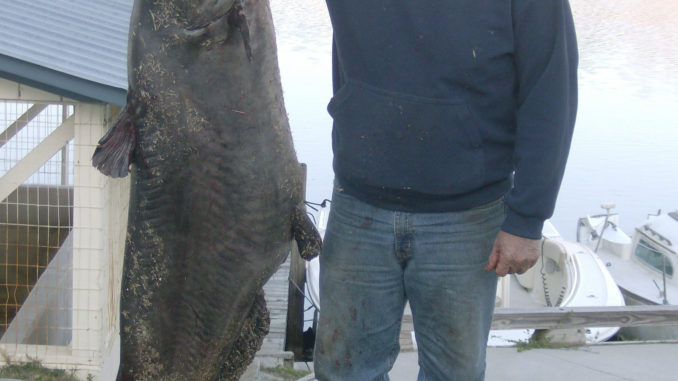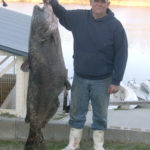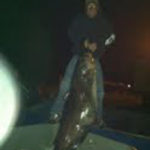
Monster catfish caught on trotline; only hook-and-line catches recognized in record book.
When commercial fishermen Leland Selph and Jimmy Dowling started checking their 150-hook trotline in Lake Moultrie on Feb. 7, they knew they had hooked a really big catfish. They just didn’t know it was the biggest ever caught in South Carolina waters.
“When we first pulled him up, he just started pulling,” said Selph who moved to Cross, S.C., from Florida’s Lake Okeechobee in 1989 to fish commercially for catfish. “We could see him down the line, about 50 hooks or so away, and I had to cut a bunch of hooks off the line so we could get him in.”It took the two of them nearly 30 minutes to finally drag the monster Arkansas blue catfish into the boat.
“We can only fish with a small hook, but he was hooked good in the corner of the mouth,” Selph said. “We just happened to catch him at the right time, with the water colder. If it had been summertime, we would not have been able to do anything with him.”
Selph and Dowling, also of Cross, headed for Black’s Camp on the Diversion Canal to weigh the huge catfish, but there was a problem with the scales at Black’s, so they wound up at Hill’s Landing just up the Canal, where the big cat tipped the scales at over 138 pounds.
The official weight of 136 pounds, 6 ounces, came a day later when Chad Holbrook, a fisheries biologist for the S.C. Department of Natural Resources, weighed it on certified scales. The huge catfish measured 56 inches long and had a girth of about 42 inches.
“This fish would have surpassed the current state record of 109 pounds, 4 ounces, had it been angled with a rod and reel,” Holbrook said.
That fish was caught in 1991 from the Tailrace Canal by George A. Lijewski of Summerville.
Fish caught on trotlines or by other non-game devices are not eligible for state record listing.
“Regardless of the harvest method, it demonstrates the potential for world-record size blue catfish that exists in the Santee Cooper system and gives anglers an idea of what kind of gear it will take to land the next record,” Holbrook said.
Native to the Mississippi River drainage, blue catfish were introduced in South Carolina in 1965 with an initial stocking of 180 sub-adults into Santee Cooper reservoir. They were first observed reproducing in 1967 and began to enter the sport fishery in the mid 1970s.
“Since those early days, blue catfish have become a major component of the reservoir’s annual fish production and have become one of the top sport fishing targets,” said biologist Scott Lamprecht of the SCDNR.
Lamprecht said blue catfish will eat just about anything available. Recent stomach content observations have included ducks, sea gulls, coots, amphiumas, snails, eels, mayflies, and crawfish. However, their typical diet consists of mussels, clams, insect larva, and fish. In winter months they often gorge on cold-stressed menhaden and shad, adding as much as 30 percent to their body weight.
South Carolina classifies blue catfish as a non-game fish, which means they may taken by any legal method of harvest, including trotlines, fish traps, bush hooks, bow fishing, as well as by rod and reel. There is no daily limit for blue catfish, but in an effort to direct most of Santee Cooper’s large blue catfish resource to rod-and-reel anglers, a limit of one fish per day greater than 36 inches, regardless of harvest method, was enacted in 2007.
Selph had caught a number of very large catfish from Santee Cooper waters before the 136-pound behemoth decided to dine on his cut menhaden offering.
“I have caught a lot of fish that weighed 75 to 77 pounds, but before this my biggest one was about 85 to 90 pounds,” said Selph who turned his big catfish over the Holbrook and Lamprecht for study.
But, he added, his huge blue may not be the biggest fish in Santee Cooper waters.
“I imagine there are bigger ones,” he said. “There have got to be bigger ones.”






Be the first to comment